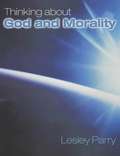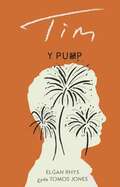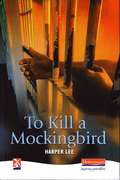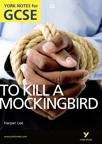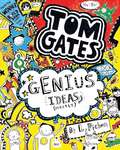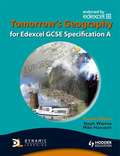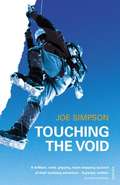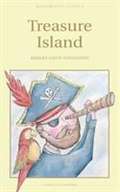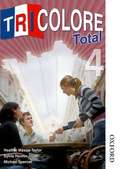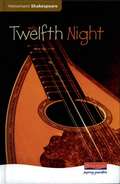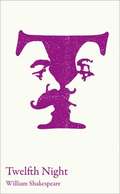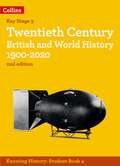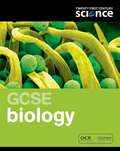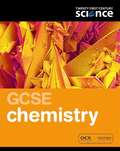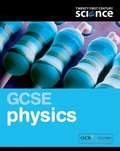- Table View
- List View
Thinking about God and Morality
by Leslie ParryThinking About God and Morality sets out a refreshing new approach towards this stimulating area of religious study. Written by a Senior Examiner it links with the AQA Religious Studies GCSE (Short) Course. The first half of the book considers the existence and nature of God and revelation. The second half includes issues of faith and morality, looking at moral decisions, issues of life and death, and relationships. It is also concerned with such global issues as the created world, poverty and war and peace. Lesley Parry has an exciting and accessible approach to teaching Religious Studies at Key Stage 4, and addresses the issues of good exam technique, as well as the content of the course.
Thinking about God and Morality
by Leslie ParryThinking About God and Morality sets out a refreshing new approach towards this stimulating area of religious study. Written by a Senior Examiner it links with the AQA Religious Studies GCSE (Short) Course. The first half of the book considers the existence and nature of God and revelation. The second half includes issues of faith and morality, looking at moral decisions, issues of life and death, and relationships. It is also concerned with such global issues as the created world, poverty and war and peace. Lesley Parry has an exciting and accessible approach to teaching Religious Studies at Key Stage 4, and addresses the issues of good exam technique, as well as the content of the course.
Thinking about God and Morality
by Leslie ParryThinking About God and Morality sets out a refreshing new approach towards this stimulating area of religious study. Written by a Senior Examiner it links with the AQA Religious Studies GCSE (Short) Course. The first half of the book considers the existence and nature of God and revelation. The second half includes issues of faith and morality, looking at moral decisions, issues of life and death, and relationships. It is also concerned with such global issues as the created world, poverty and war and peace. Lesley Parry has an exciting and accessible approach to teaching Religious Studies at Key Stage 4, and addresses the issues of good exam technique, as well as the content of the course.
Thinking about God and Morality (PDF)
by Leslie ParryThinking About God and Morality sets out a refreshing new approach towards this stimulating area of religious study. Written by a Senior Examiner it links with the AQA Religious Studies GCSE (Short) Course. The first half of the book considers the existence and nature of God and revelation. The second half includes issues of faith and morality, looking at moral decisions, issues of life and death, and relationships. It is also concerned with such global issues as the created world, poverty and war and peace. Lesley Parry has an exciting and accessible approach to teaching Religious Studies at Key Stage 4, and addresses the issues of good exam technique, as well as the content of the course.
Tim (Y Pump)
by Elgan Rhys gyda Tomos JonesDyma'r gyntaf o bum nofel yng nghyfres Y Pump. Mae Tim ar fin cyrraedd Ysgol Gyfun Llwyd ar ddechrau Blwyddyn 11. A fydd ei griw o ffrindiau newydd yn gallu ei helpu i ffeindio cysur? [The first of five novels in the series Y Pump. Tim is about to enter Year 11 in Ysgol Gyfun Llwyd, but will his crew of new friends be able to help him find solace?]
To Kill a Mockingbird: New Windmills (PDF)
by Harper LeeScout, the keen-eyed narrator, and her brother Jem interrupt their games to champion their lawyer father when, in a hostile, racist town in the American South, he battles to defend Tom, who is black and accused of murder. Readership age: 11 to 18. Interest level:14+.
To Kill a Mockingbird: New Windmills
by Harper LeeScout, the keen-eyed narrator, and her brother Jem interrupt their games to champion their lawyer father when, in a hostile, racist town in the American South, he battles to defend Tom, who is black and accused of murder.
To Kill a Mockingbird: York Notes for GCSE (PDF)
by Beth SimsWritten by examiners and teachers to give you an expert understanding of the text you're studying, York Notes has the most in-depth coverage and analysis of everything from themes and contexts to characters, plots and language. There are sample answers, essay plans and specialist guidance on understanding the questions you'll be asked in an exam, together with an array of handy quotes, checklists, study tips, grade boosters and revision activities to help you learn, revise efficiently and remember everything you'll need to write the very best answers.
Tom Gates, Book 4: Genius Ideas (Mostly) (PDF)
by Liz PichonSeeing Delia without her sunglasses on is a BIG shock for Tom, but that's nothing compared with the surprise that Dad has in store with his new-found fitness regime! He says he's going to compete at the school Sports Day. Can you even imagine the horrendous shame that will bring? Meanwhile Tom, Derek and Norman are also busy with a training regime of their own - practising with Dogzombies to make sure they're ready for the school talent show.nbsp;
Tomorrow's Geography for Edexcel GCSE Specification A (PDF)
by Steph Warren Mike HarcourtEndorsed by Edexcel, this brand new edition of a best selling title is designed to prepare your students for exam success for the latest Edexcel A specification. Covers all four units of the specification, including comprehensive coverage of Unit 1 Geographical Skills and Challenges for the Planet, all the content for Units 2 and 3, and Controlled Assessment for Unit 4.
Touching the Void
by Joe SimpsonTouching theVoid is the heart-stopping account of Joe Simpson's terrifying adventure in the Peruvian Andes. He and his climbing partner, Simon, reached the the summit of the remote Siula Grande in June 1995.
Translation
by RnibThis diagram shows three triangles; the original triangle and its translation in two different ways to two new positions. A locator dot and title are shown. These must always be at the top left of the page when the image is the right way up. There is a graph with all four quadrants showing, and the x and y axes ranging from -3 to 3. The x and the y axes intersect at the origin marked by an O. Axes values are positive to the right and to the top of the diagram. Axes values are negative to the left and to the bottom of the diagram. Not all axis division marks are labelled. Some of the braille uses maths code notation. When a shape is translated, it stays the same shape and orientation; only its position changes. The original triangle is in the top left quadrant. There is a translation to the right of a value of 4, and then a translation down of a value of 1. There is also a second translation, right to a value of 4, and then down to a value of 4. The movement of the first triangle is indicated by a heavy dashed line.
Translation
This diagram shows three triangles; the original triangle and its translation in two different ways to two new positions. A locator dot and title are shown. These must always be at the top left of the page when the image is the right way up. There is a graph with all four quadrants showing, and the x and y axes ranging from -3 to 3. The x and the y axes intersect at the origin marked by an O. Axes values are positive to the right and to the top of the diagram. Axes values are negative to the left and to the bottom of the diagram. Not all axis division marks are labelled. Some of the braille uses maths code notation. When a shape is translated, it stays the same shape and orientation; only its position changes. The original triangle is in the top left quadrant. There is a translation to the right of a value of 4, and then a translation down of a value of 1. There is also a second translation, right to a value of 4, and then down to a value of 4. The movement of the first triangle is indicated by a heavy dashed line.
Translation
This diagram shows three triangles; the original triangle and its translation in two different ways to two new positions. A locator dot and title are shown. These must always be at the top left of the page when the image is the right way up. There is a graph with all four quadrants showing, and the x and y axes ranging from -3 to 3. The x and the y axes intersect at the origin marked by an O. Axes values are positive to the right and to the top of the diagram. Axes values are negative to the left and to the bottom of the diagram. Not all axis division marks are labelled. Some of the braille uses maths code notation. When a shape is translated, it stays the same shape and orientation; only its position changes. The original triangle is in the top left quadrant. There is a translation to the right of a value of 4, and then a translation down of a value of 1. There is also a second translation, right to a value of 4, and then down to a value of 4. The movement of the first triangle is indicated by a heavy dashed line.
Treasure Island (PDF)
by Robert Louis Stevenson'Fifteen men on the dead man's chest-Yo-ho-ho and a bottle of rum!' Treasure Island is a tale of pirates and villains, maps, treasure and shipwreck, and is perhaps the best adventure story ever written.
Tricolore Total 4: Student Book (PDF)
by Mascie-Taylor, Heather|Honnor, Sylvia|Spencer, MichaelThe fourth stage in the new edition of this tried and trusted course has been updated to meet the requirements of the new GCSE specifications, providing a range of blended resources to help support and develop independent learning and creativity.
Turning forces (large print)
by Rnib BookshareThis diagram shows turning forces acting on an open-ended wrench in the middle of the page with the head of a nut in its jaws. There is a locator dot shown, which will be at the top left of the page when the image is the right way up. The handle of the wrench is to the left centre of the page. The jaws are to the right. The six-sided head of the nut fits into the jaws of the wrench, with a dot at its centre that marks its fulcrum (pivot point). To the right of the nut is an arrow showing the anti-clockwise direction of turning. Down the page from the left of the wrench is an arrow pointing down, showing the direction of force and a label showing the force in Newtons. Further down, running horizontally, is a dimension line that shows the distance from the end of the handle to the pivot point.
Turning forces (UEB contracted)
by Rnib BookshareThis diagram shows turning forces acting on an open-ended wrench in the middle of the page with the head of a nut in its jaws. There is a locator dot shown, which will be at the top left of the page when the image is the right way up. The handle of the wrench is to the left centre of the page. The jaws are to the right. The six-sided head of the nut fits into the jaws of the wrench, with a dot at its centre that marks its fulcrum (pivot point). To the right of the nut is an arrow showing the anti-clockwise direction of turning. Down the page from the left of the wrench is an arrow pointing down, showing the direction of force and a label showing the force in Newtons. Further down, running horizontally, is a dimension line that shows the distance from the end of the handle to the pivot point.
Turning forces (UEB uncontracted)
by Rnib BookshareThis diagram shows turning forces acting on an open-ended wrench in the middle of the page with the head of a nut in its jaws. There is a locator dot shown, which will be at the top left of the page when the image is the right way up. The handle of the wrench is to the left centre of the page. The jaws are to the right. The six-sided head of the nut fits into the jaws of the wrench, with a dot at its centre that marks its fulcrum (pivot point). To the right of the nut is an arrow showing the anti-clockwise direction of turning. Down the page from the left of the wrench is an arrow pointing down, showing the direction of force and a label showing the force in Newtons. Further down, running horizontally, is a dimension line that shows the distance from the end of the handle to the pivot point.
The Twelfth Night
by John Seely William ShakespeareThe gentle melancholy and lyrical atmosphere of Twelfth Night have long made the play a favourite with Shakespearian audiences. The plot revolves around mistaken identities and unrequited love, but is further enlivened by a comic sub-plot of considerable accomplishment. In it, Sir Toby Belch and his companion outwit the pretentious Malvolio, who despite suffering their most outrageous and insulting practical jokes, emerges as an almost noble figure. This edition of Twelfth Night opens up Shakespeare to all students and offers a complete guide to studying the play. It is ideal preparation for KS3 as well as GCSE English and English Literature. This Heinemann Shakespeare edition of Twelfth Night includes: activities after all main scenes to help understanding of the play; introductions to Shakespeare's theatre and language to aid contextual understanding; accessible explanations and summaries to help ensure student understanding.
Twelfth Night (Collins Classroom Classics) (PDF)
by William Shakespeare Peter Alexander Noel CassidyExam board: Edexcel; Cambridge; CXC Level & Subject: GCSE 9-1; IGCSE; CSEC English B First teaching: September 2015; September 2019; First exams: June 2017; June 2021 Exam board: AQA B, Edexcel, OCR Level & Subject: AS & A Level English Literature First teaching: September 2015; First exams: June 2017 This edition of Twelfth Night is perfect for GCSE-level and A-level students, with the complete play in an accessible format, on-page notes, introduction setting the context, timeline, character and theme indexes.
Twentieth Century British And World History 1900-2020: (PDF)
by Robert Selth Laura Aitken-BurtProvide a coherent chronological KS3 history curriculum with 50 knowledge-rich lessons on twentieth century world history. Spark pupils’ curiosity, develop their understanding of the past and equip them to investigate the past as a historian. Ignite an interest in twentieth century history through memorable and compelling narratives, rich contextual detail and extraordinary people Help all students to think critically about the past by focusing on the knowledge they need and then checking their understanding Build secure positive identities and cultural capital with culturally and geographically diverse coverage including five new global history units for the 2nd edition Support pupils’ long-term learning with knowledge organisers on key vocabulary, people, places, and dates Put knowledge into context with a full timeline covering the broad geographical scope of the period studied Easy to implement in your school with the 10 unit/ 5 chapter structure and overarching enquiry question per unit Deliver excellent lessons and save time on your planning with the supportive Teacher Guide available free on collins.co.uk, including suggested activities and sources, quick quizzes, answers and essay ideas Unit 1: The First World War Unit 2: The USSR Unit 3: Germany and the Nazis Unit 4: The Second World War Unit 5: Wartime Britain Unit 6: Modern China Unit 7: The Cold War Unit 8: Civil Rights in the USA Unit 9: Decolonisation Unit 10: Postwar Britain
Twenty First Century Science: Student Book (PDF)
by Carol Levick Mike Kalvis Neil Ingram Nick Owens Cris Edgell Cliff Porter Ann Fullick Jacqueline PunterFully updated and revised to match the new 2011 specifications. Produced in partnership with OCR, University of York Science Education Group and Nuffield Foundation.
Twenty First Century Science: GCSE Chemistry (PDF)
by Emma Palmer Mike Shipton Vicky Wong Helen Harden John Lazonby Andrew Hunt Ted Lister Dorothy WarrenThe second editions of these bestselling Twenty First Century Science resources have been developed in partnership with OCR, the University of York Science Education Group and the Nuffield Foundation. The resources have been fully updated to match the 2011 specifications.
Twenty First Century Science: Student Book (PDF)
by David Sang Robin Millar Carol Tear Elizabeth SwinbankFully updated and revised to match the new 2011 specifications.nbsp;Produced in partnership with OCR, University of York Science Education Group and Nuffield Foundation.nbsp; The Student Book helps you create lively and relevant science lessons. Packed full of lively and motivating material that support the specifications' proven ability to increase uptake at A Level. Engaging opening pages start every module by explaining why the science is important and clearly highlighting the ideas about science from the specification. 'Find Out About' boxes help students understand what they need to learn while linking to the specification and helping them monitor their own progress. Module openers include a checklist covering ideas students should already be familiar with from previous science teaching, linking back to KS3 and building links between modules in GCSE. Questions are provided throughout to help students pause and reflect on what has been learnt, helping to reinforce content throughout the course. Illustrated step-by-step explanations make difficult concepts easier to understand. Key words needed to understand the specification are highlighted to reinforce important knowledge.
